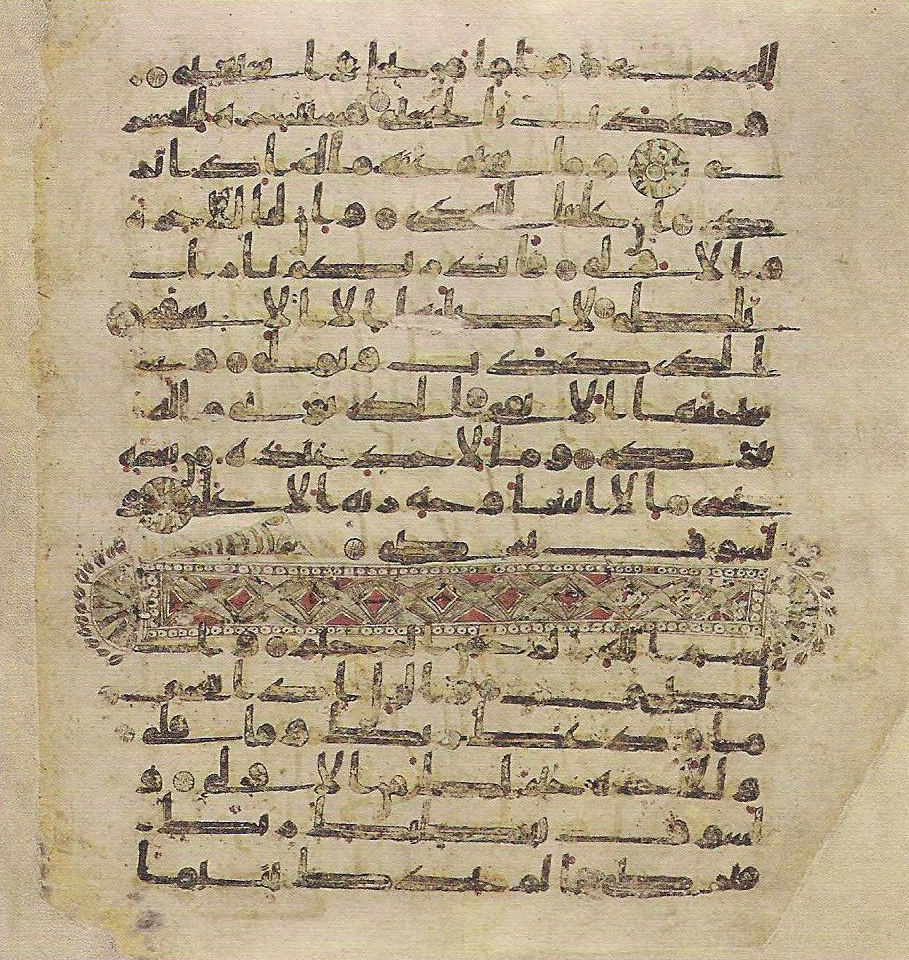Topkapı Muṣḥaf on:
[Wikipedia]
[Google]
[Amazon]
 The Topkapı manuscript or Topkapı Quran (Also known as Topkapı Qurʾān Manuscript H.S. 32 or Topkapı H.S. 32). is an early manuscript of the
The Topkapı manuscript or Topkapı Quran (Also known as Topkapı Qurʾān Manuscript H.S. 32 or Topkapı H.S. 32). is an early manuscript of the
/ref> Halaseh also shows that based on the paleography of the manuscript, folios 2r–6v and 11 seems to have been created by another hand and added to the manuscript at a much later stage. According to
 The Topkapı manuscript or Topkapı Quran (Also known as Topkapı Qurʾān Manuscript H.S. 32 or Topkapı H.S. 32). is an early manuscript of the
The Topkapı manuscript or Topkapı Quran (Also known as Topkapı Qurʾān Manuscript H.S. 32 or Topkapı H.S. 32). is an early manuscript of the Quran
The Quran, also Romanization, romanized Qur'an or Koran, is the central religious text of Islam, believed by Muslims to be a Waḥy, revelation directly from God in Islam, God (''Allah, Allāh''). It is organized in 114 chapters (, ) which ...
dated to the middle 2nd century AH (mid 8th century AD).
This manuscript is kept in the Topkapi Palace Museum, Istanbul
Istanbul is the List of largest cities and towns in Turkey, largest city in Turkey, constituting the country's economic, cultural, and historical heart. With Demographics of Istanbul, a population over , it is home to 18% of the Demographics ...
, Turkey
Turkey, officially the Republic of Türkiye, is a country mainly located in Anatolia in West Asia, with a relatively small part called East Thrace in Southeast Europe. It borders the Black Sea to the north; Georgia (country), Georgia, Armen ...
. It is traditionally attributed to Uthman ibn Affan
Uthman ibn Affan (17 June 656) was the third caliph of the Rashidun Caliphate, ruling from 644 until Assassination of Uthman, his assassination in 656. Uthman, a second cousin, son-in-law, and notable Companions of the Prophet, companion of ...
(d. 656). However, a recent study by Professor Rami Hussein Halaseh indicates that attributing H.S. 32 to "ʿUthmān or claiming its production during the first/seventh century is historically inaccurate."
Similar illuminations can be found in the Dome of the Rock
The Dome of the Rock () is an Islamic shrine at the center of the Al-Aqsa mosque compound on the Temple Mount in the Old City (Jerusalem), Old City of Jerusalem. It is the world's oldest surviving work of Islamic architecture, the List_of_the_ol ...
in Jerusalem, the Umayyad Mosque
The Umayyad Mosque (; ), also known as the Great Mosque of Damascus, located in the old city of Damascus, the capital of Syria, is one of the largest and oldest mosques in the world. Its religious importance stems from the eschatological reports ...
in Damascus and other Umayyad
The Umayyad Caliphate or Umayyad Empire (, ; ) was the second caliphate established after the death of the Islamic prophet Muhammad and was ruled by the Umayyad dynasty. Uthman ibn Affan, the third of the Rashidun caliphs, was also a membe ...
monuments. The size of this manuscript is . According to Halaseh, H.S. 32 currently contains about 97.78% of the text of the Qur'ān. With only two pages (23 verses) lacking, this manuscript is the closest to the complete text of the Quran. Mehmed Ali Pasha, Governor of Egypt, sent this manuscript to the Ottoman Sultan Mahmud II
Mahmud II (, ; 20 July 1785 – 1 July 1839) was the sultan of the Ottoman Empire from 1808 until his death in 1839. Often described as the "Peter the Great of Turkey", Mahmud instituted extensive administrative, military, and fiscal reforms ...
as a gift in the 19th century (CE).
The paleographic assessment indicates that the Topkapi manuscript comes closest to those writings that date back to the 8th century. (cf. the examples in Déroche: Abbasid, page 36).Kodex Topkapı Sarayı Müzesi at corpus coranicum/ref> Halaseh also shows that based on the paleography of the manuscript, folios 2r–6v and 11 seems to have been created by another hand and added to the manuscript at a much later stage. According to
Tayyar Altıkulaç
Tayyar Altıkulaç (born 1938) is a Turkish Islamic scholar and former politician who served as the 12th president of the Presidency of Religious Affairs from 1978 to 1986. He also served as a member of the Grand National Assembly of Turkey for tw ...
, the manuscript dates to somewhere in the second half of the first century AH to the first half of the second century AH based on vowelling and dottings.
Also cf. E. İhsanoǧlu: "An examination of the Topkapı Muṣḥaf shows that it was written with a developed kufic script
The Kufic script () is a style of Arabic script, that gained prominence early on as a preferred script for Quran transcription and architectural decoration, and it has since become a reference and an archetype for a number of other Arabic scripts ...
. The shape of the letters does not confirm to the writing style of the early Muṣḥafs attributed to Caliph ʿUthmān, which were written on vellum in his period and therefore known as the Muṣḥafs of Caliph ʿUthmān. (...) Apparently this Method of Abū al-Aswad al-Duʾalī nvented after the death of Caliph ʿUthmānwas carefully followed in placing the vowel marks of the Topkapi Palace copy. Single dots were placed in red ink above, beside or below the letters." (Altıkulaç, al-Muṣḥāf al-Sharif (Preface), page 9).
"According to the evaluation of Munadjdjid, neither this Muṣḥaf nor the Muṣḥafs located in Tashkent, al-Mashhad al-Ḥusayn in Cairo and in the Museum of Turkish and Islamic Works in Istanbul were the Muṣḥafs attributed to Caliph ʿUthmān; however considering the differences in their script, the centuries when they were copied and their different dimensions, they must have been copied from the Muṣḥafs attributed to Caliph ʿUthmān. For this reason, each of them was called the (Muṣḥaf ʿUthmān)" (Altıkulaç, al-Muṣḥaf al-Sharif, page 80).
References
Quranic manuscripts Topkapı Palace {{quran-stub